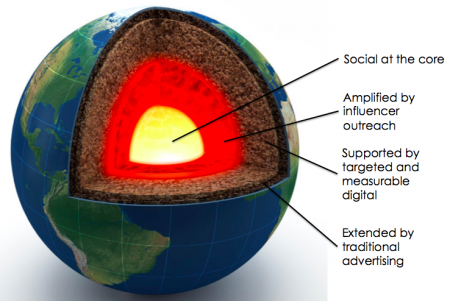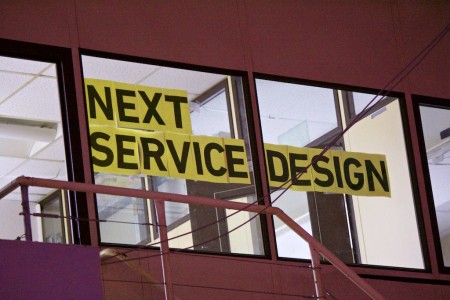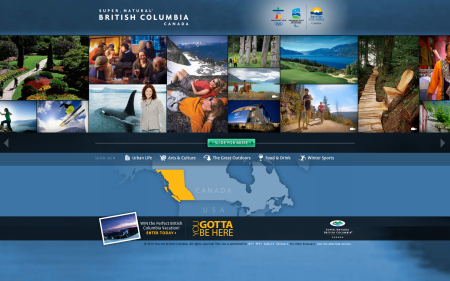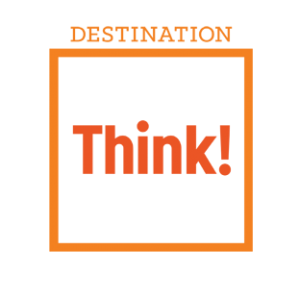The Archives
-
Experience Design, Internet, Management, Marketing, social media, Travel & Tourism
3 things to think about in 2013
Happy New Year everybody! Here are three things off the top of my head that are important things to consider for 2013. Do you have any more?
1) PUT SOCIAL AT THE CORE
I think it’s pretty clear by now that social media has a major impact on the travel decision making process. If your tourism business or DMO hasn’t realized this yet you better catch up. You should be at level 3 or higher by now.
Most marketers think of social media as an add-on to a traditional campaign, or at least start with traditional thinking. It’s time to flip it around. Start with a social idea and support it with traditional methods. Or do traditional things in a social way. For example, we recently worked with a DMO who let it’s Facebook community vote on what photos would be published in it’s visitor guide.
2) START USING SERVICE DESIGN
Mitigating a mediocre experience with brilliant marketing doesn’t cut it anymore. The experience IS your marketing and the stories your visitors tell each other is what it’s all about. You have two choices. First choice is to join the race to the bottom and keep offering specials, discounts and special offers. The second one is to create remarkable experiences people love and want to be part of, regardless of what it costs.
If your choice is the latter, you need to start thinking about service design. When you’re an operator you need to start thinking about the end-to-end experience you offer your guest. When you are a DMO you need to think about the end-to-end destination experience. Service design is gaining a lot of momentum in Europe, especially in Austria where destinations are starting to take an active role in the design of the destination experience.
3) MOBILE: THINK DEVICE PLUS CONTEXT
I was on a panel at a conference in Barcelona recently and somebody asked about mobile. Before I could even think about it I said “it’s not about mobile, it’s about device + context”. I probably heard it somewhere before but I have never really thought about it like that. But it’s true. Whether you build a desktop site, a mobile site, an adaptive site or an app, it’s not the device that’s important. It’s the context of use.
When you search google maps, it takes into account your device, where you are and what date and time it is. That’s the context of your usage and the information you get back takes that into account. You need to so the same thing. A consumer accessing your content at home is looking for very different things than a consumer walking down the street in your destination.
Now here’s the kicker. Often that means people use another website than yours. Somebody walking down the street looking for a restaurant is going to use Google Maps, Yelp or Tripadvisor, not a DMO website. Even a consumer planning as trip might never even make in onto your website (hello travel bloggers). Your content online strategy needs to include content on third party websites. From inspiration to transaction. Just like we used to do it in the 90s with travel guides and tour operator brochures.
-
Internet, Marketing, tourism bc, Travel & Tourism
New on HelloBC.com: interactive driving routes
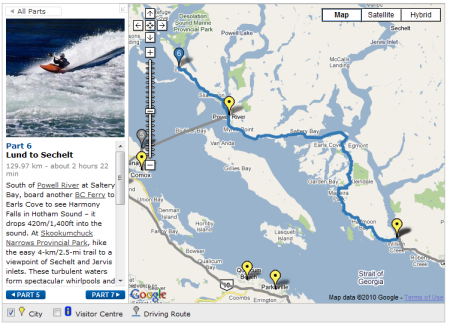
A few weeks ago we launched new functionality on HelloBC.com and it’s probably the best work we’ve done to date.
BC is a large and diverse province and in order to fully experience it you need some wheels. To make planning a driving vacation easier, we added new functionality to enhance our driving routes content and make it easier to plan a trip.
This new section takes full advantage of Google Maps, includes detailed maps, driving routes and information about cities and towns you pass through. The location of our Visitor Centres are also present. Long routes, like the Heritage Discovery Circle Tour (3,498 km) are divided into manageable parts. You’ll read about highlights, what you can expect and see photos of the scenery you’ll find along the way.
Go check out our new driving routes. We’re already working on Phase 2 to make the experience even better.
Thank you Holly, Patrick, Tammy, Sarah, Karen, Mikala, Rob, Ana, Galina and everybody else who made this happen.
-
Internet, Marketing, Travel & Tourism
Tourism BC 2010 Online Olympics activities: #9 – inspiring people new to BC
I’ve covered what we’re doing with Olympic related websites and how we drive interested people to our websites. To make sure the traffic we receive during the games is maximized we’ve worked for a long time on making the website the best it can be. The next few days are dedicated to it these activities.
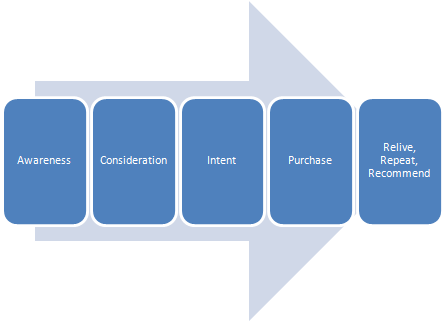
Purchase cycle (well, the one we use)
HelloBC typically receives a lot of visitors who already know something about BC. In the purchase cycle, they are beyond the awareness stage and are already considering or intending to take a trip. What we’ve learned over the years is that these people are in planning mode and need information first, inspiration second. That’s why content is a huge priority for us (more about content later this week).
During the games, a lot of people will learn about BC for the first time. We call these people the newly aware. People earlier in the cycle need to learn about the destination and be inspired to visit. Everything related to the Olympics will provide a lot of inspiration and when they visit HelloBC, we’d like to continue to inspire and educate the consumer about everything BC has to offer in the process.
In order to meet the needs of the consumer in the early stages of the planning process, we created a new section for the newly aware. This section is different from the rest of the website. It contains large imagery, videos and is created in a way that encourages exploration. It was designed and created by our technology partner T4G in collaboration with Fjord West and the result is also technically interesting because it high interactivity but contains no Flash thanks to T4G’s HTML/CSS/Javascript wizz Larry.
-
Internet, Marketing, Travel & Tourism
The Role of DMO and CVB Websites – Start with your website user
09.07.09 | Permalink | 2 CommentsThe role of our website is a favourite topic among senior management at Tourism BC and has been for a long time. PhoCusWright’s Destination Marketing: Understanding the Role and Inpact on Destination Marketers flared up another round last summer. I’ll spare you those details but here are some of my thoughts.
PhoCusWright rightfully notes that almost every DMO is different they way they’re structured, funded and organized but that key issues and challenges are very similar. I’ve been talking to my peers around the world for 10 years now and that’s definely true.And it’s becoming more challenging all the time. Online innovation continues are a rapid pace while a DMO website is now at the heart of all marketing activities. My perspective a user centered one. If you don’t meet your website user’s goals, there’s no hope you’ll ever meet any of your organizational or stakeholder objectives, because your visitors won’t stick around.
One place to start is to figure out where a person’s place is in the planning (or purchase) cycle.Find out if somebody:
- knows about the destination but is not considering a trip yet
- is considering a trip but doesn’t have concrete plans yet
- has decided to visit but hasn’t booked yet
- has booked and it filling in the details
- is in the middle of the trip, continuing planning
The answer to the question posed above could radically change the approach you should take. If most people are in the first group, they’re looking for a reason to visit. They need to be inspired. Big imagery, videos that connect on an emotional level and experiential stories work really well in this phase. Most DMO websites serve consumers in this phase very well.
But if somebody is in the third group, the role of the website is not to lose the sale. They’re already inspired and motivated. Most DMO websites don’t do very well here. When somebody visits a DMO website in this phase, it probably means there’s just a few nagging questions and they need answers. Details. How long does it take to drive there? How expensive is everything?Is the museum open on Mondays? Is there enough to do for the whole family?
Forget the emotional video and big images. The website can look like Craigslist. They just want detailed information (they could also be looking for a deal by the way, but that’s another poll to run).
PhoCusWright has polled consumers and their report includes valuable information about where consumers say they visit DMO websites in the process. We’ve polled our website visitors about this for a while now and our numbers are a bit different from PhoCusWright’s. This leads me to believe that it might vary based on the destination.
It’s super easy to find out where your visitors are in the process. Poll them. Find out. And use it internally as you discuss the role of your website. And get the PhoCusWight report, it’s worth the money.
-
Uncategorized
Marketing your small tourism business in the 21th century: #2 Get your website in order
03.25.08 | Permalink | 10 CommentsThis topic probably needs more than one post because I receive a lot of website related questions from tourism businesses. I’m sure I don’t have to tell you that when you operate a tourism business that doesn’t rely on walk-by traffic only, your website is your most important marketing vehicle. Your website has to be up to snuff. I’ll try to keep it simple.
First of all; hire a professional, or a company who build websites. There are still people who think that buying a copy of dreamweaver or frontpage will save them a few bucks by building a website themselves. Please don’t. You’re busy enough already. A simple way to find the right company or professional is to look at your colleague’s websites and get a recommendation.
You first need to think about what you want to achieve with your website in a way that you can measure; sales, transactions, customer emails, phonecalls, etc. The more tangible the better. This is your objective. Your exact objective depends on your type of business. But as a tourism business, I think in most cases you should go for the sale.
There are 4 main aspects to building a website; visual design, content, usability, technology. Most people focus on design and technology (because its fun). Instead, you should worry about content and usability (not so much fun). Content is what your website visitors need, usability is organizing content and providing the functionality to make things easy for your website visitors. The design should reflect your business (if you run a flowery B&B, your website can be flowery as well). Finally, technology is what enables you to deliver everything above.
Your web professional(s) should be competent in all areas. But you’re the expert of your business and should know what content is needed to turn a website visitor in a customer. In general, people don’t visit tourism operator websites for the fun of it. Their visit has a purpose. They want to validate their intent to visit your business, sort out the details and hopefully purchase.
Validating the decision is about the excitement of the experience. Consumers want to picture themselves having fun kayaking a river, playing a round of golf or relaxing in the hot-tub of your B&B. Pictures, videos and testimonials are the most compelling ways to achieve this. The details they nedd depend on your type of business and it can include simple things such as opening hours, your location, pricing, policies, etc. Some consumers just want to make sure a business is legit. Providing contact info is often crucial to meet this.
Make sure you get the content your professional need. Don’t just focus on making your website look pretty. It’s about the content. You probably don’t even need a ‘redesign’, you just need better content (ok, I think I made my point). Finally, you need a mechanism to get the sale. If you can offer an online reservation often, great. If you can’t there are other options.
Looking for an example of a good operator website? Nahanni River Adventures won the Canada eTourism Award for best website. It’s a great example of using pictures, videos and testimonials to validate the intent, provide detailed information, and provide a mechanism to get the sale.
I hope to provide a bit more detail in certain areas soon. In the meantime, if you have any questions about any of this, or have anything to add, or need help finding the right online professional, please leave a comment or drop me an email. My email address is under my picture in the right column. -
Internet, Travel & Tourism
Is there a place for a destination based Social Network?
11.19.07 | Permalink | 8 CommentsThere are opinions floating around about the viability and usefulness of destination based Social Networks. Karin Schmollgruber for example doesn’t have a lot of faith in a social network for a single destination.
A touristic social network is not about a destination, but about travelers of that destination. Which in turn means, that a community cannot be established around a destination. It has to be created around the emotions, experiences, likes and dislikes of real people.Karin is one of the thought leaders in the travel 2.0 blogging community and I respect her opinion a lot. But I disagree with her about this one. I think the CoolAustria and Holland 2.0 experiments have taught us a few lessons. But I don’t reach the same conclusion.
The destination based Social Networks mentioned above (and now Sweden as well) all implemented some form of “be like Facebook” strategy, combined with a plethora of Web 2.0 tools. The core challenge with this approach is that travelers who are planning trips need information and don’t necessarily want to become part of another Social Network, create a profile, make friends and more, they just want to plan a vacation.
With Holland as an exception, these social networks are also separated from their official websites, a huge missed opportunity. The result from all of the above is that all these networks suffer from low participation, where high participation is needed. facebook is great, but a ‘be like Facebook’ approach is not going to work for a destination. Karin is absolutely right about that.
Some suggest that travel related social networks is just another source for content. Simply aggregate User Generated Content from third party networks, and you’re done. New Zealand has done it, Canada has done it. This is definitely useful content for travelers. And I like simplicity, but I don’t like to oversimplify things. I thought Web 2.0 was about interactivity and two way communication. Aggregating User Generated Content and publishing it on a website is Web 1.5.DMO’s need to build strong relationships with consumers, and help them plan and book vacations, before and during their trip, by allowing all relevant stakeholders to participate on a destination website. These stakeholders are:
- Travelers, planning a trip, or sharing experiences and content about a trip
- Residents, they are a sub-group of travelers, but a very important one
- The tourism industry, selling their tourism products
- The DMO itself, providing the ‘official’ information
The opportunity for a destination based social network is to harness industry, passionate residents and past travelers, and engage them in a dialog with travelers to assist them with their trip planning. This is a natural extension of what DMOS’s do. They sell the destination by connecting travelers with tourism product (connecting supply with demand). Destinations already have relationships with their industry. They need find and encourage their ‘brand advocates’ to engage on their networks.
Groups for cities, towns, sectors, etc. will form. There will be differences of opinion, and that’s ok. That’s how trip planners can evaluate the opinion of many against their own criteria and make the best decision. Certain content can be sourced from third parties. What’s the point of creating your own product rating system when you can source it directly from Tripadvisor for example. Other content will have to be created on a destination based social network.
With the introduction open social standard, there is an opportunity to leverage existing networks people are already part of. If somebody can take their social graph with them, all of a sudden we can leverage the existing connections (friends) people already have, adding a whole layer of additional usefulness and credibility.
The social network I envision and intent to create for HelloBC.com is a mash-up of our official information, aggregated third party content, combined with our resident advocates, passionate past travelers and tourism businesses, all interacting with travelers in an open and transparent way. The direct, and two-way interaction is an opportunity to add the credibility, objectivity and authenticity travelers are looking for. And it will be nothing like Facebook.
